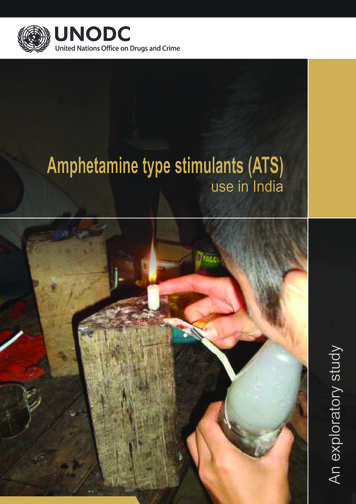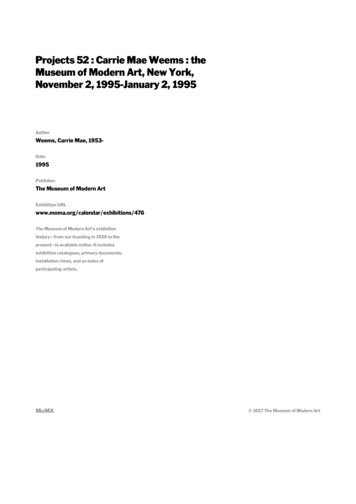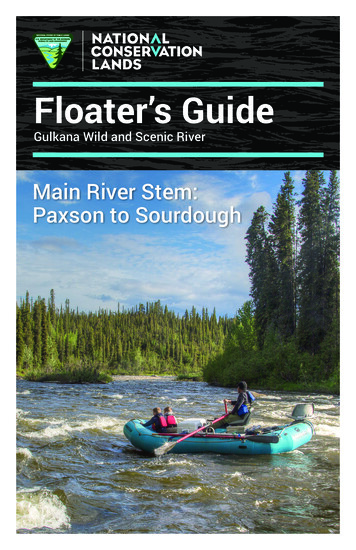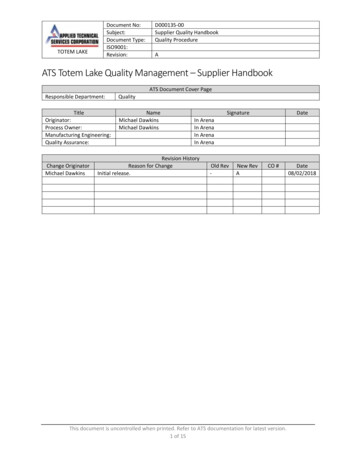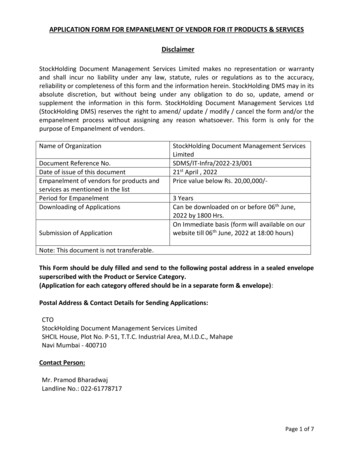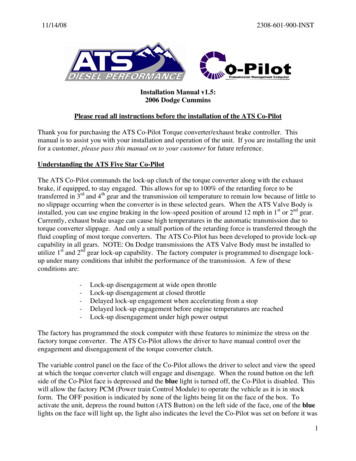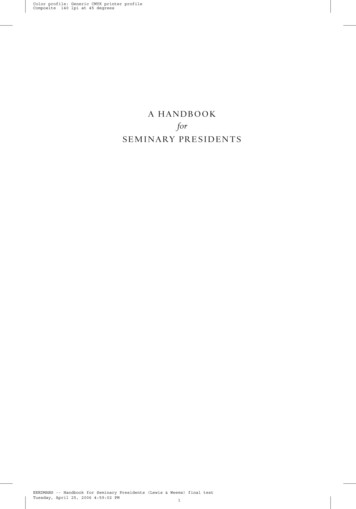
Transcription
Color profile: Generic CMYK printer profileComposite 140 lpi at 45 degreesA HANDBOOKforS E M I N A RY P R E S I D E N T SEERDMANS -- Handbook for Seminary Presidents (Lewis & Weems) final textTuesday, April 25, 2006 4:59:02 PM1
Color profile: Generic CMYK printer profileComposite 140 lpi at 45 degreesThis book is published in cooperation with theAssociation of Theological Schoolsin the United States and CanadaEERDMANS -- Handbook for Seminary Presidents (Lewis & Weems) final textTuesday, April 25, 2006 4:59:02 PM2
Color profile: Generic CMYK printer profileComposite 140 lpi at 45 degreesA H A N D BO O KforS E M I N A RY P R E S I D E N T SG. Douglass Lewis, editorLovett H. Weems Jr., associate editorWilliam B. Eerdmans Publishing CompanyGrand Rapids, Michigan / Cambridge, U.K.EERDMANS -- Handbook for Seminary Presidents (Lewis & Weems) final textTuesday, April 25, 2006 4:59:02 PM3
Color profile: Generic CMYK printer profileComposite 140 lpi at 45 degrees 2006 Wm. B. Eerdmans Publishing Co.All rights reservedWm. B. Eerdmans Publishing Co.255 Jefferson Ave. S.E., Grand Rapids, Michigan 49503 /P.O. Box 163, Cambridge CB3 9PU U.K.Printed in the United States of America11 10 09 08 07 067 6 5 4 3 2 1Library of Congress Cataloging-in-Publication DataA handbook for seminary presidents /edited by G. Douglass Lewis and Lovett H. Weems Jr.p.cm.Includes bibliographical references.ISBN-10: 0-8028-3397-7 / ISBN-13: 978-0-8028-3397-6 (cloth: alk. paper)1. Theological seminary presidents.I. Lewis, G. Douglass (Granville Douglass), 1934II. Weems, Lovett H. (Lovett Hayes)BV4166.5.H362006230.071 1 — dc222006008542www.eerdmans.comEERDMANS -- Handbook for Seminary Presidents (Lewis & Weems) final textTuesday, April 25, 2006 4:59:02 PM4
Color profile: Generic CMYK printer profileComposite 140 lpi at 45 degreesContentsAcknowledgmentsviiiIntroductionxiG. Douglass Lewis andLovett H. Weems Jr.1. The President’s Vocation and Leadership1Daniel Aleshire, Cynthia Campbell, Kevin Mannoia2. The President’s Role in Administrationand Personnel Management18Adolf Hansen, Jean Stairs, Kent M. Weeks3. The President’s Role in Governance35Robert Cooley, Christa Klein, Louis Weeks4. The President’s Role in Defining Missionand Strategic PlanningDavid L. Tiede, David Draper, Wilson YatesvEERDMANS -- Handbook for Seminary Presidents (Lewis & Weems) final textTuesday, April 25, 2006 4:59:02 PM559
Color profile: Generic CMYK printer profileComposite 140 lpi at 45 degreescontents5. The President’s Role as Academic Leader72Charles E. Bouchard, Susan Thistlethwaite,Timothy Weber6. The President’s Role in Financial Management89Anthony Ruger, John Canary, Steven Land7. The President’s Role in Managing Facilities114Ward Ewing, Thomas Graves, Robert Landrebe8. The President’s Role in Institutional Advancement126Rebekah Burch Basinger, C. Samuel Calian, Robert F. Leavitt9. The President’s Role in Enrollment Managementand Student Issues140David McAllister-Wilson, Craig Williford,David Neelands10. The President’s Role with External Authorities154Vincent Cushing, Donn Morgan, Albert Aymer11. Personal and Professional Well-being of a President166Donald Senior, Maxine Beach, Byron Klaus12. The President’s Role as Symbolic,Culture-forming Leader177Richard J. Mouw, William McKinney, Brian Stiller13. The Unique Issues for Racial/Ethnic Presidents189Edward Wheeler, Michael Battle, David Maldonado14. The Unique Issues for Women PresidentsMartha Horne, Heidi Hadsell, Laura MendenhallviEERDMANS -- Handbook for Seminary Presidents (Lewis & Weems) final textTuesday, April 25, 2006 4:59:02 PM6206
Color profile: Generic CMYK printer profileComposite 140 lpi at 45 degreesContents15. The Unique Issues for CEOs ofUniversity-based Theological Schools220James Hudnut-Beumler, Harold W. Attridge,Frederick J. Finks16. The Unique Issues for Presidentsof Canadian Theological Schools233Dorcas Gordon, Marvin Dewey, Ron MercierContributors249viiEERDMANS -- Handbook for Seminary Presidents (Lewis & Weems) final textTuesday, April 25, 2006 4:59:03 PM7
Color profile: Generic CMYK printer profileComposite 140 lpi at 45 degreesAcknowledgmentsThis handbook is a project of the Association of Theological Schools inthe United States and Canada (ATS). It involved the full, diverse spectrum of schools from across the Association, which now consists ofmore than two hundred fifty theological schools representing RomanCatholic, Orthodox, evangelical, and mainline Protestant seminaries,spread geographically across the United States and Canada. More thanone hundred individuals, most of them seminary presidents, were involved in the project as writers, editors, critics, or advisers. It is truly abook written by seminary presidents for seminary presidents.The project emerged out of the desire to provide a resource forpresidents that would enable them to do their work better and, in turn,develop more effective seminaries that are better able to serve churchesand communities across North America. Our research showed that nocomparable resource is available for seminary presidents. We hope thishandbook conveys both a depth of understanding about the nature androle of a seminary president and practical information that enables apresident to do a better job.We have never worked on a project like this that had such enthusiastic involvement from so many people. They all know theological educationfrom the inside and are committed to its mission. They not only contributed from their experience and knowledge but also testified to how muchviiiEERDMANS -- Handbook for Seminary Presidents (Lewis & Weems) final textTuesday, April 25, 2006 4:59:03 PM8
Color profile: Generic CMYK printer profileComposite 140 lpi at 45 degreesAcknowledgmentsthey learned from engaging in the project. Current and future generationsof seminary presidents owe all of them a great debt. The repayment of thedebt will come, we hope, in the form of higher quality and more effectivepresidential leadership in theological schools across our countries. What along-term gift that will be to churches and society as a whole.A special word of thanks must go to three key staff members atATS: Daniel Aleshire, Nancy Merrill, and Bill Myers. They encouragedand supported the project from beginning to end. They also contributedas writers, editors, advisers, and critics. Thanks also go to the ReligionDivision of Lilly Endowment Inc., which funded the Leadership Education program of ATS. The Handbook for Seminary Presidents project isa key part of that program’s work with seminary presidents. CraigDykstra, Vice President, Religion, and John Wimmer, Program Director, affirmed and supported the project. Joe Arnold, Executive Assistant, Lewis Center for Church Leadership, Wesley Theological Seminary, provided administrative support for the project.Each chapter had a team of three persons who designed and created it. The writer/editor had primary responsibility for constructingthe chapter. His or her name is listed first under each chapter heading.The other two persons were designated as contributing writers. A list ofall the contributors and the institutions they served is included at theend of the book. Listed below are members of the Advisory Committeewho thought through the early design of the project and a group of outside readers who critiqued a first draft of each chapter. We thank allthese individuals for their valuable input.One further note of thanks must go to ATS and its staff, who continue to create and deliver a variety of resources to support theologicaleducation. ATS will continue to develop its Website and will there provide a section of resources for seminary presidents. The resources listedat the end of each chapter of this handbook will be on the Website, andas new resources helpful to presidents appear they will be added to thelist. We invite presidents who discover particularly helpful materials tomake ATS aware of them for addition to the Website. By that means thecommunity of presidents can continue to contribute to one another’slearning, growth, and practice.G. Douglass Lewis, EditorLovett H. Weems Jr., Associate EditorixEERDMANS -- Handbook for Seminary Presidents (Lewis & Weems) final textTuesday, April 25, 2006 4:59:03 PM9
Color profile: Generic CMYK printer profileComposite 140 lpi at 45 degreesacknowledgmentsAdvisory CommitteeDaniel Aleshire The Association of Theological Schools in theUnited States and CanadaCharles BouchardMyron McCoyAquinas Institute for TheologySaint Paul School of TheologyWilliam Myers The Association of Theological Schools in theUnited States and CanadaDavid NeelandsTrinity College Faculty of DivinityCornelius Plantinga Jr.Calvin Theological SeminaryLouis B. Weeks Union Theological Seminary and PresbyterianSchool of Christian EducationBarbara WheelerAuburn Theological SeminaryOutside ReadersBruce BirchWesley Theological SeminaryMichael Cooper-WhiteGettysburgScott CormodeLutheran Theological Seminary atClaremont School of TheologyNorman DewireMethodist Theological School in OhioDavid GreenhawEden Theological SeminaryPhilip KreyLutheran Theological Seminary at PhiladelphiaMyron McCoySaint Paul School of TheologyJohn Phelan Jr.North Park Theological SeminaryReiss PotterveldRussell RicheyJune StoweLancaster Theological SeminaryCandler School of Theology of Emory UniversityWesley Theological SeminaryBarbara Brown ZikmundHartford SeminaryxEERDMANS -- Handbook for Seminary Presidents (Lewis & Weems) final textTuesday, April 25, 2006 4:59:03 PM10
Color profile: Generic CMYK printer profileComposite 140 lpi at 45 degreesIntroductionG. Douglass Lewis and Lovett H. Weems Jr.What’s So Special about Seminary Presidents?Another book about presidents and what they do? Aren’t there alreadyenough books on presidents, leadership, and management? True, theshelves of bookstores and libraries, the Web, and thousands of articleslie in wait to inform us about leaders — what they should do and howthey should do it. The author of every book or article believes his or herwords contain something a little different and unique. We, however,want to claim some distinction for this book.Only those who have occupied the office of a seminary presidentknow the special demands, challenges, opportunities, stresses, and joysof the job. It is not a job for everyone. At its heart it is a vocation, a calling. Those deciding to apply for or accepting an invitation to serve insuch a position usually have been through a serious process of discernment. A commitment to service and response to a call usually characterize those who wear the mantle of seminary president most easily andsuccessfully.A president stands at the center point of an institution. He or she ison the “hot seat” of a daily struggle to understand and fulfill the seminary’s mission while maintaining its economic vitality. No presidentcan have the detailed knowledge required to make each and every component of a seminary run smoothly and effectively. Nevertheless, a presxiEERDMANS -- Handbook for Seminary Presidents (Lewis & Weems) final textTuesday, April 25, 2006 4:59:03 PM11
Color profile: Generic CMYK printer profileComposite 140 lpi at 45 degreesintroductionident remains ultimately responsible for the effectiveness of each component and for integrating the parts into the whole of the institution.Such overarching responsibility requires knowledge and skill in multiple areas. But more importantly, it requires the ability to choose, support, and hold accountable those who have the specific abilities neededfor the institution to work effectively.There is a hard-to-define, almost mysterious, dimension of presidential leadership. No one chapter in this handbook addresses it specifically, but many allude to it. Who the president is personally and how heor she functions, even in small matters, deeply influence how others inthe institution perceive what is possible for the organization. It is morethan knowledge and skill. It is “persona” — the depth of a person, one’sspirituality, one’s interaction with others. It is saying the right words oncritical occasions, being courageous and confident in the midst of crisisand conflict, conveying hope, and enabling others to become more thanthey thought they could be. There is no one pattern or prescription forhow a president performs this mysterious dimension of leadership, butpeople in the community know when it is present or absent. A presidentcan manage an institution with specific knowledge and skills; but without this more elusive dimension of leadership, success is unlikely.The contributors to and supporters of this book maintain thatpresidents are key to whether their institutions succeed or falter. Obviously a president alone does not wholly determine the health and wellbeing of a seminary. But how a president functions, manages, and leadsprovides the linchpin that holds the other components of the institutiontogether. Does this lofty claim overstate the role of president? We inviteyou to read these chapters and comprehend the range of things a president must know and do and how these in turn affect and shape their institutions.What Does It Take to Be a Successful President?As we noted, a seminary president’s role is best grounded in a sense ofvocation or call. Without a call, it can become a mere “job,” and the intense demands of the position feel weightier and more energyconsuming. But call alone does not ensure success. It also requires individual gifts and graces. One can catalog the desirable attributes for presxiiEERDMANS -- Handbook for Seminary Presidents (Lewis & Weems) final textTuesday, April 25, 2006 4:59:03 PM12
Color profile: Generic CMYK printer profileComposite 140 lpi at 45 degreesIntroductionidents, but the exact combination of personal gifts obviously varies and“one size does not fit all.” Many different personalities can succeed inthe role of president.The particular context and culture of the seminary are anothervariable. Certain personalities match one setting and not another. Noformula can guarantee a successful match. A seminary president needsinsight to recognize the unique culture of the school and the ability toadapt to that culture while at the same time transforming the institutionand its culture to fulfill more effectively a mission unique in time andplace.No president, no matter how personally gifted or culturally attuned, can succeed without a body of knowledge and a set of skills. Theposition is demanding because it requires such a broad range of knowledge and skills. The president does not need to know all the details butmust at least ask the right questions and pick people who have the skillsto manage each area.This book provides the framework and some of the specific information a president needs to survey the major tasks of the job. The various chapters in this handbook cover the major areas of a seminary thatdemand presidential attention. Each chapter defines a particular area ofresponsibility and the unique role of the president in it. An analysis anddiscussion of the area identify many of the critical issues likely to confront a president, suggest some best practices for dealing with these issues, and pose some of the questions a president should be asking.Finally, each chapter includes a section that suggests additional resources for those who want or need to explore the area more deeply.Why Do We Need Successful Seminaries?The logic behind this handbook project goes something like this: Theultimate goal is to affect the quality and depth of religious life in America. The primary institutions that affect religious life are the many anddiverse local congregations in communities across North America. Thequality of the ministry in these congregations is greatly shaped by theirpastoral leadership. Pastors who are clear about their vocation, welltrained, and well sustained are more likely to develop effective ministries. Seminaries are a key link in the chain of calling, preparing, andxiiiEERDMANS -- Handbook for Seminary Presidents (Lewis & Weems) final textTuesday, April 25, 2006 4:59:03 PM13
Color profile: Generic CMYK printer profileComposite 140 lpi at 45 degreesintroductionsustaining pastoral leaders. Thus, we are back to the need for effectiveseminaries and the role that a president plays in developing and leadinga theological school to fulfill its mission and also maintain economic vitality.Within the larger context of higher education in North America,seminaries are admittedly very small educational institutions. How canthey be so influential? First, they are a primary theological resource,sustaining and interpreting the historic faith in the contemporary context. Second, they are the primary educational resource for preparingpastoral leaders for the churches of the continent. Seminaries have a tremendous multiplier effect. By a conservative estimate, a pastor whospends thirty years in congregational ministry will likely touch and variously influence one hundred thousand individuals and numerous community groups. No other channel has such direct impact on the religiouslife of cultures and nations. A positive intervention in this chain of religious influence can achieve a tremendous payoff. Our intervention focus is on the seminary president and the key role he or she plays in thechain.The Association of Theological Schools, through its accreditingand programmatic roles, and the generous funding of the Religion Division of Lilly Endowment Inc. have helped to develop this fundamentallogic. They have invested substantially in the encouragement and support of seminary presidents in the belief that they are key actors in shaping and leading theological education and thereby affect the chain of religious influence in North America.To our knowledge, there is no other resource like this Handbookfor Seminary Presidents that is so specifically focused on this criticalleadership group. Our hope is that in some small but influential way itwill contribute to the greater effectiveness of seminary presidents, theirschools, the leaders they educate, and the congregations and communities they serve.xivEERDMANS -- Handbook for Seminary Presidents (Lewis & Weems) final textTuesday, April 25, 2006 4:59:03 PM14
Color profile: Generic CMYK printer profileComposite 140 lpi at 45 degreesCHAPTER 1The President’s Vocation and LeadershipDAN I EL ALESH I RE , The Association of Theological SchoolsCYN T H IA CAMPBELL , McCormick Theological SeminaryKEVI N MANNOIA, Azusa Pacific UniversityOVERVIEWIntroductionVocationPersonal Faith and Faithful WorkPrivileged Work with PeersInstitutional Mission and Scholarly AdministrationLeadershipLeading a CommunityLeading with AwarenessLeading with Institutional Will and Personal HumilityLeading through ChangeLeading by Telling the StoryAdditional Resources1EERDMANS -- Handbook for Seminary Presidents (Lewis & Weems) final textTuesday, April 25, 2006 4:59:03 PM15
Color profile: Generic CMYK printer profileComposite 140 lpi at 45 degreesa handbook for seminary presidentsIntroductionSamuel heard a voice in the night. He was attending to the needs of anaging Eli and assumed the voice was Eli’s, so he went to the old priest,only to hear Eli say that he had not called. Samuel went back to his cotand, once again, heard the voice calling him. He went to Eli and discovered that Eli had not called this time either. Samuel returned to bed forwhat was left of the night and, a third time, heard a voice. A third timeSamuel went to Eli, and a third time Eli said he had not called. There isno reason why Samuel should have thought the voice in the night belonged to someone other than Eli, for, as the text notes, “the word ofthe Lord was rare in those days” (1 Sam. 3:1), and “Samuel did not yetknow the Lord, and the word of the Lord had not yet been revealed tohim” (v. 7). Eli was very old, and no doubt wounded from watching hissons sin themselves into faithlessness. After the third time that Samuelcame to him, Eli’s sadness lifted. He began to suspect that Samuel washearing the voice of Yahweh. So Eli told Samuel that, if he heard thevoice again, he should answer, “Speak, Lord, for your servant is listening” (v. 9). The voice came, and Samuel responded as instructed. TheLord spoke, but it was a word of such judgment on Eli’s house thatSamuel was afraid to tell Eli. Eli insisted that Samuel tell him, and thepriest recognized that these painful words were surely from the Lord.Most seminary presidents have heard this story told tenderly andhave studied it critically. The tender hearing is in the authentic pietythat brings students to theological schools, as year after year they indicate that their most compelling motivation to undertake theologicalstudy was a sense of God’s call.1 The tender hearing continues in thehopeful sermons preached at graduates’ ordination services, often using this text. The critical study struggles with the judgment that is thereason for the call. There has been sin and faithlessness, and the wordthat Samuel hears is worrisome and troubling. Stories of divine judgment, if not subjected to critical study, can too easily become a coverfor human judgments that are inevitably more harsh and less just thanthe judgment of God.Leading a seminary gives a president more than the occasional opportunity to wake in the night and hear voices. It may be the voices of1. ATS Student Information Program, “Entering Student Questionnaire.”2EERDMANS -- Handbook for Seminary Presidents (Lewis & Weems) final textTuesday, April 25, 2006 4:59:03 PM16
Color profile: Generic CMYK printer profileComposite 140 lpi at 45 degreesThe President’s Vocation and Leadershipthe funds that are needed but not yet raised, the voices of students whohave left the relative prosperity of other careers for the relative povertyof seminary study, the voices of donors who have given sacrificially, thevoices of more needs than a school can ever hope to meet, the voices ofdeep religious need in the culture, or the voices of divisive struggles inthe church. There are many voices, enough to fill the day and the night.Some are tender and reassuring. Others are shrill, even intimidating.Like Samuel’s call, these callings invite presidents to action — presidential work is about getting up and doing things. Unlike Samuel, whoheard the multiple callings of God to do one thing, the leader of a theological school receives one calling that involves doing many things.We use the word calling in many ways, most of which do not resemble Samuel’s experience. Seminary students, for example, say thatthey come to seminary because they have experienced a “call.” The seminary admitted them, but the seminary did not call them. It is differentwith presidents. They should undertake this work only with a deepsense of calling, but that calling is like Samuel’s. It is not a “calling” towhich one aspires; it is a calling that one experiences in the context of aboard or religious superior’s summons to this work.In this chapter, we identify several issues related to vocation andleadership. Vocation, or calling, has many facets, but we will mentiononly a few. Leadership has even more, but once again, we have chosen toaddress only a few of them.VocationPresidential leadership in a theological school can be a source of bothdeep satisfaction and exceptionally hard work. The satisfactions ofguiding an institution that forms religious leaders and informs thoughtful theological discourse are many. The presidency grants access to privileged moments as donors translate their faith commitments into funding for programs, students, and the future of the school. It oftenprovides opportunities to participate in significant denominationaldecision-making and ecumenical engagement. But presidential leadership can also be difficult work — finding and managing the necessaryresources, dealing with difficult personnel issues, navigating the sometimes complex terrain of academic governance, and attending thought3EERDMANS -- Handbook for Seminary Presidents (Lewis & Weems) final textTuesday, April 25, 2006 4:59:03 PM17
Color profile: Generic CMYK printer profileComposite 140 lpi at 45 degreesa handbook for seminary presidentsfully to multiple constituencies. It is difficult because institutional leadership always is exercised in a world of competing demands andloyalties, where a greater number of important things need to be donethan can be done. Religious work that is bound on the one hand by deepsatisfactions and on the other by persistent difficulties is best accomplished with a deep sense of calling, of vocation.The vocation of the presidency of a theological school, of course,begins with the discipleship that all Christians share, and it typicallycontinues with the broad tasks of vocational ministry, because mostseminary presidents are ordained. Whether a president is ordained ornot, the calling of the seminary presidency goes further; it involves theleadership of a theological school. The call to leadership in a theologicalschool is similar in many ways to the call to leadership in other institutions. Leadership of a theological school differs from leadership in congregations, however, because schools do not have the volunteer culturethat dominates parishes and congregations, even though those congregations may have large ministerial and program staff structures. Leadership of a theological school differs from a denominational agency because a seminary tends to have more diffused and shared patterns ofgovernance than the more corporate structures of most denominationalagencies. The call to leadership of a theological school is different onlyto the extent that the culture, ethos, and structure of a seminary tend tobe somewhat unique. Rather than rehearse the more generic issues ofthe call to leadership, we have chosen to explore facets of that call wherepersonal identity interacts with presidential work. In this way, “vocation” refers to the interior sense of commitment that interacts with theinstitution’s call to exercise presidential leadership.Personal Faith and Faithful WorkIn an interview with three seminary presidents who were about to retire, former In Trust editor William MacKaye asked what had nourishedthem and sustained them in their work.2 Bill Lesher, retiring after presidencies at the Lutheran School of Theology in Chicago and Pacific Lu2. William MacKaye, “Describing the New Leader: What’s Needed in a TheologicalSchool President Today,” In Trust (Summer 1997): 20-23.4EERDMANS -- Handbook for Seminary Presidents (Lewis & Weems) final textTuesday, April 25, 2006 4:59:04 PM18
Color profile: Generic CMYK printer profileComposite 140 lpi at 45 degreesThe President’s Vocation and Leadershiptheran in Berkeley, said that he didn’t know how anyone got through thiswork without an active life of devotion. The other interviewees werequick to concur. Maintaining a life of faith is as overwhelmingly obviousas it is devastatingly difficult. Ministers who handle the holy for a livingcan become oblivious to its drama in their own lives. Seminaries areseedbeds, at least that is what the name implies, and presidents canspend so much time hoeing and weeding the seedbed that they fail tocultivate the faith that is central to the first calling — the call to Christian discipleship. Seminary life can be spiritually enriching. Seminaryworship, preaching, and Eucharistic celebrations can be powerful moments — privileges to which few other Christians have access. Thework and worry load, however, can render them ineffective. So presidents need to remind themselves of the obvious and take seriously theirvocation of personal faith. The rhythms of prayer and worship, andstudy and service, however they are defined and practiced in theschools’ religious communities, are crucial for sustaining believers whoare seminary presidents. They provide the personal foundation and integrity that hard work requires, and leading a theological school is hardwork.Religious callings are often associated with difficult tasks, likeleaving Ur of the Chaldees, or taking up a cross, or getting into a shakyboat and heading toward Rome. Leadership, by definition, is hard work.If a seminary could go where it needs to go with little effort, if its variousconstituencies agreed without fail on its directions and best course ofaction, if the money just floated down from heaven, then leadershipwould be easy and, probably, unnecessary. James Dittes, in a book several decades old now, reminded pastors that those troubling momentswhen the people in the congregation say no, or break their promises, orresist the gospel’s claim on their lives are the very moments that definethe pastoral vocation.3 It is precisely because people in congregationsdo these kinds of things from time to time that they need pastors andseminaries need leaders. Seminary leadership is not always hard; it is often far more rewarding than it is demanding. However, there are moments of great difficulty in almost every presidency, moments of stressand anxiety, moments of unrelenting complexity. A personal sense of3. James Dittes, When the People Say No: Conflict and the Call to Ministry (San Francisco: Harper & Row, 1979).5EERDMANS -- Handbook for Seminary Presidents (Lewis & Weems) final textTuesday, April 25, 2006 4:59:04 PM19
Color profile: Generic CMYK printer profileComposite 140 lpi at 45 degreesa handbook for seminary presidentsvocation can sustain presidents in these moments. Theological schoolsneed leaders who understand that the personal price is worth payingand that the Bible’s image of the “yoke” demonstrates that the burden isbearable.Privileged Work with PeersPresidential work is privileged work and, as such, involves the vocational understanding of this privilege and its proper stewardship. Theprivilege is, first of all, one of perspective. While presidents bear theburdens
Cornelius Plantinga Jr. Calvin Theological Seminary Louis B. Weeks Union Theological Seminary and Presbyterian School of Christian Education Barbara Wheeler Auburn Theological Seminary Outside Readers Bruce Birch Wesley Theological Seminary Michael Cooper-White Lutheran Theological Seminary at Gettysburg Scott Cormode Claremont School of Theology

